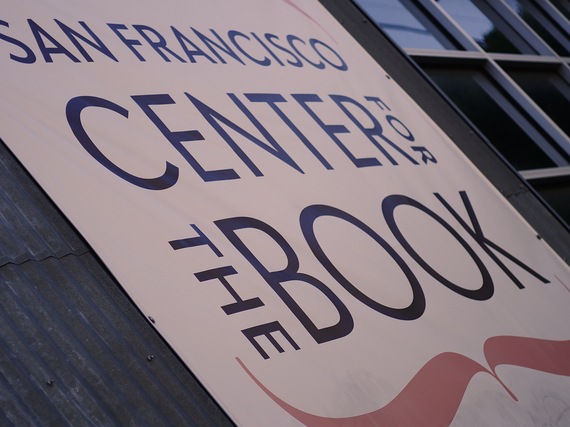Photo by author
A role reversal is among the best means to learn. I am preparing to teach again after a bit of a break. I have made most of my career in the classroom, and I have enjoyed it. I recently was a student for a week. I completed a certificate in bookbinding at the San Francisco Center for the Book, and being not especially good at the craft was instructive. I will be a better teacher for being a bad student.
Over the course of 40 hours, equivalent to a standard work week, we made four books: coptic, flat-back case bound, limp-paper bound, and classic rounded back bound. We measured, cut, glued, and, worst of all, sewed. I was inept at that last task. For the final session, another student brought in the miracle of a threader, a wire device that pulls the thread through the eye of the needle. Although that saved me much time, because silk turns out to be slippery, I was unable to pull my stitches tightly enough to create structural stability in the finished article. I was not incapable. I improved albeit modestly. The belief in the possibility of improvement is a pre-requisite for it. I will need much belief, for I need much improvement. Nobody is born a bookbinder.
My results will be gifts for family members who will count the sentiment. They are not ready for Etsy.
This entire enterprise was humbling. I felt as if I were in first-grade. I was reminded of my failings as a student -- I was a consistent underachiever until graduate school, when I felt challenged. I would not want to rely on an excuse of diagnosed attention deficit disorder, but for the life of me I cannot sit still through instructions. At least as an adult, I am capable of persisting; as a child, I would have given up at the point of the first imperfection.
Some of the other students had read books about making books, and they had made earlier attempts -- they brought in examples or showed photographs. I had done a bit of that as well.
All of us agreed that there was no substitute for experience. I am persuaded that learning through doing is the ideal means of learning.
But the teacher plays a major role. I have been an autodidact for the most part. That likely is explained by my weakness listening in person. I probably know what I know of most disciplines from listening, on my own and at my pace, to dozens of courses on tape while commuting -- the multitasking ironically forces me to pay attention.
The bookbinding instructor, Juliayn Coleman, a professional in the field, was excellent. She seemed a bit of character, as one might expect of someone who earns a living doing what others would dismiss as obsolete; she explained she had been a pastry chef and librarian, and, on the side, she knitted items such as the socks she was wearing.
What made her outstanding was not her artistry, which I would not doubt, but her pedagogy. She and I accidentally switched text blocks (the inside of the book, minus the covers) at some point, and it was immediately apparent. If I had a first edition to repair and could afford her services, I would not hesitate to hire her. A teacher must do more, though, than demonstrate her own mastery. She should impart it to others, which depends on techniques less of the subject at hand than of teaching itself. Juliayn was able to do that, because she had thought about how to communicate. She established rapport and trust, which allowed her to be firm and directive as needed.
People naturally enjoy making things. I felt a sense of accomplishment from my lopsided volumes, as I do not from cerebral exertions. That is why we take it upon ourselves. Even if we could purchase a superior product, we want to participate in the process. That is how our lives are enriched. It is imperative to try what we cannot do. Our days are impoverished otherwise.
An aspect of learning is realizing one's ignorance. Friends who admired what I had done flattered me. They were genuinely unable to distinguish the details that I could discern from just the intensive classes, such as my crooked alternation of the two colors on the headbands.
Perhaps the most important lesson I take away from bookbinding is about the value of practice and the corresponding necessity of patience. Our era does not encourage deferred gratification, with celebrity being bestowed upon the young and wealth being generated by entrepreneurs who retire before their parents do. The 10,000 hour rule popularized by Malcolm Gladwell, as a standard for developing competence, is a beneficial guide regardless of whether that exact time is required for expertise.
Hand bookbinding belongs to a category of activities that compel us to consider what matters, Intrinsically anachronistic, it is slow beyond what rational utilitarian measures would favor. Digital alternatives have no physicality and cheap paperbacks are assembled with adhesives. Yet as long as people read, an activity that forms the foundation of culture, there will be people who appreciate the tactile reality of the traditional codex that enables their imagination.
May we continue to transmit and share these skills, from teacher to student. They sustain community.

